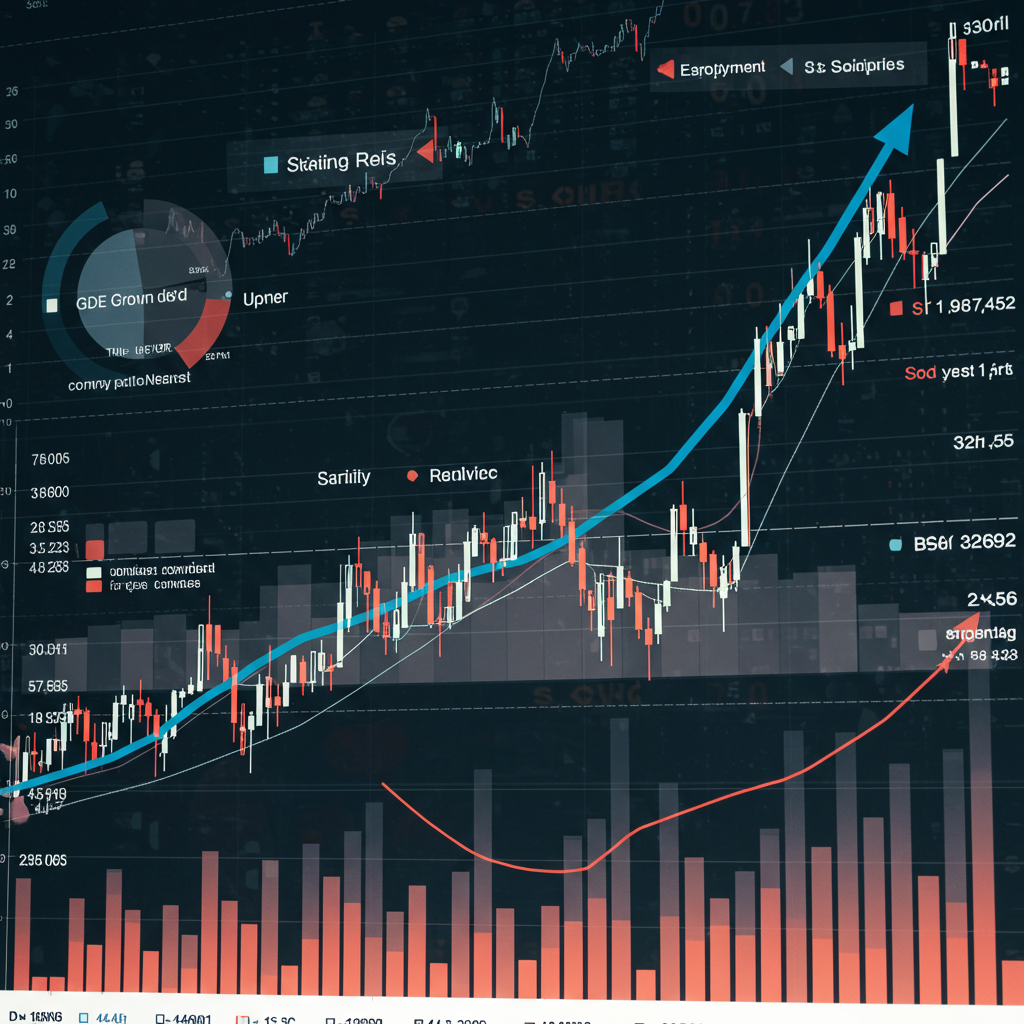The U.S. stock market surged to new record highs on Thursday, capping a holiday-shortened week with robust gains. This powerful rally came as fresh government data painted a picture of an unexpectedly strong U.S. job market. Investors responded by driving stocks higher across broad sectors, while simultaneously pushing bond yields sharply upward. The underlying signal? The American economy appears more resilient than some recent concerns suggested, recalibrating expectations for future Federal Reserve actions.
Market Indices Scale New Peaks
Major U.S. indices saw significant advances by the close of trading. The S&P 500 index climbed 0.8%, marking its fourth all-time closing high in just five trading sessions. This broad-market benchmark finished the day at 6,279.35, adding 51.93 points. The Dow Jones Industrial Average also posted a strong gain, adding 344.11 points, or 0.8%, to close at 44,828.53. Meanwhile, the Nasdaq composite, heavily weighted towards technology stocks, rose by 1%, adding 207.97 points and closing at 20,601.10. Even the small-cap focused Russell 2000 index moved into positive territory for the year, gaining 0.8% year-to-date as of the market close.
Widespread Gains Propel rally
The market strength was notably widespread, indicating broad-based investor confidence. Companies whose fortunes are closely tied to consumer spending and economic health performed particularly well. Travel and leisure stocks saw significant bumps, with Expedia climbing 3.2% and Norwegian Cruise Line steaming 2.9% higher. Bank stocks, often seen as bellwethers for economic activity, also showed solid performance. Citigroup shares rose 2.3%, and JPMorgan Chase gained 1.9% by the end of the session.
Strong Jobs Report Exceeds Expectations
The primary catalyst for Thursday’s market movement was a highly anticipated report on the U.S. job market. Government data revealed that employers added a surprising 147,000 more jobs to their payrolls last month than they cut. This acceleration in hiring surpassed Wall Street analysts’ expectations and provided a strong signal that the U.S. labor market remains robust. The positive figures emerged despite lingering worries about the potential negative impacts of President Donald Trump’s tariffs on both the economy and inflation. Carl Weinberg, chief economist at High Frequency Economics, commented positively on the data, stating, “There is nothing to complain about here. You cannot find any evidence of a nascent recession in these figures.” Further supporting the optimistic labor outlook, a separate report indicated that fewer U.S. workers applied for unemployment benefits last week, suggesting a decrease in layoff activity.
Yields Leap as Rate Cut Bets Fade
While stocks cheered the signs of economic strength, the reaction in the bond market was even more pronounced. Yields on U.S. Treasury bonds jumped significantly following the jobs report. This surge in yields reflects investors adjusting their expectations regarding the Federal Reserve’s future interest rate policy. Strong economic data often reduces the likelihood that the central bank will cut interest rates, as robust growth can potentially fuel inflation. Prior to the report, some investors anticipated the Fed might lower rates to counter potential economic headwinds, particularly those related to tariffs.
Dramatic Shift in Fed Expectations
The shift in sentiment was clearly visible in market data. Traders in the futures market drastically reduced their perceived probability of the Fed cutting its main interest rate at its next meeting later that month. According to data from CME Group, the chance of a rate cut plummeted from nearly 24% just a day earlier to less than 5% after the release of the jobs report. This significant recalibration in expectations directly influenced bond prices and yields. The yield on the benchmark 10-year Treasury note rose to 4.34% from 4.30% late Wednesday. The two-year Treasury yield, which is highly sensitive to near-term Fed rate expectations, saw an even larger jump, climbing to 3.88% from 3.78%. Federal Reserve Chair Jerome Powell has previously indicated the central bank is adopting a patient approach, preferring to wait and assess the effects of Trump’s tariffs on the economy and inflation before making further moves on interest rates. While lower rates can stimulate economic activity by making borrowing cheaper, they also risk adding inflationary pressure, a concern potentially magnified by tariffs.
Tariff Concerns Still Loom
Despite the strong jobs data, uncertainty surrounding trade policy persists. Many of President Trump’s significant proposed taxes on imports are currently paused but are scheduled to take effect next week unless trade deals are reached with other countries. A recent survey by the Institute for Supply Management (ISM) highlighted that even though U.S. services industries returned to growth last month after a contraction in May, many companies remain concerned about the impact of tariffs. The survey noted businesses reporting increased costs due to existing and potential tariffs. One company specifically cited in the agriculture, forestry, fishing, and hunting sector stated, “Increased cost from tariffs and the potential for tariffs is impacting cost increases.” This indicates that while broad economic data looks good, specific sectors still face significant headwinds from trade tensions.
Noteworthy Stock Movements
Beyond the broader sector trends, individual stock performance also captured attention. Datadog shares rallied sharply, surging 14.9% on the announcement that the cloud monitoring company would be added to the widely followed S&P 500 index before trading begins the following Wednesday. Inclusion in the S&P 500 typically drives investment, as many index funds and investment managers are required to hold shares of member companies. Datadog is set to replace Juniper Networks in the index, following Juniper’s combination with Hewlett Packard Enterprise.
On the other side of the coin, companies sensitive to higher interest rates experienced declines. Homebuilders, who rely on affordable mortgage rates to attract buyers, saw their shares fall. Sustained higher bond yields translate to potentially higher mortgage costs, which can dampen housing demand. Lennar shares sank 4.1%, while D.R. Horton dropped 2.7%.
Global Markets Show Mixed Picture
Looking beyond the United States, stock markets abroad showed a mixed performance. Indexes generally rose across much of Europe and Asia. Among specific markets, South Korea’s Kospi index climbed 1.3%, while Hong Kong’s Hang Seng index fell 0.6%, representing two of the more significant moves in regional trading. U.S. financial markets were scheduled to be closed the following day, July 4th, for Independence Day.
Frequently Asked Questions
Why did stocks and bond yields react differently to the strong jobs report?
Strong economic data like robust job growth is generally positive for stocks, as it indicates healthy business activity and consumer spending, which can boost corporate profits. Therefore, stocks rallied. However, strong economic data can also increase concerns about inflation. To control inflation, the Federal Reserve might keep interest rates higher or raise them. Higher interest rates typically make bonds less attractive relative to new bonds issued at higher rates, causing existing bond prices to fall and their yields to rise. This explains why bond yields leaped.
How are tariff concerns still impacting the US economy according to recent reports?
Despite positive job numbers, recent surveys, like one from the Institute for Supply Management (ISM), show U.S. services industries are still concerned about tariffs. Businesses report that both existing and potential future tariffs are leading to increased costs. This suggests that even with overall economic growth, specific sectors and companies are facing financial pressure and uncertainty directly related to trade policy tensions.
What does the significant drop in Fed rate cut expectations mean for investors?
The sharp decline in the market’s expectation of a Federal Reserve interest rate cut indicates that traders now believe the strong economic data makes a near-term rate reduction much less likely. For investors, this suggests that borrowing costs (like mortgage rates and business loans) may remain higher than previously anticipated. It also means sectors sensitive to interest rates, like housing, might continue to face headwinds, while financials could benefit from a higher rate environment.
Conclusion
Thursday’s market performance underscored the powerful influence of economic data on investor sentiment. A surprisingly strong jobs report fueled a broad rally in U.S. stocks, pushing major indices to new record highs, while simultaneously triggering a significant jump in bond yields as expectations for near-term Federal Reserve rate cuts evaporated. While the data suggests underlying economic strength, lingering concerns over the impact of potential tariffs remain a factor contributing to uncertainty in specific sectors. As the market looks ahead, attention will likely focus on upcoming trade policy decisions and the Federal Reserve’s commentary on the economy’s trajectory.
Word Count Check: 995




